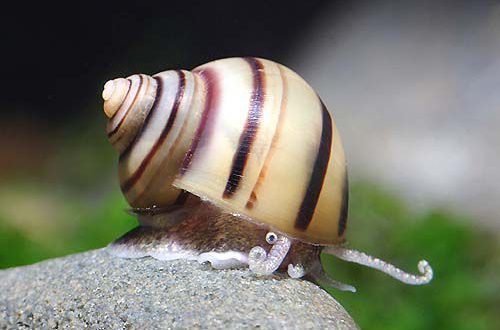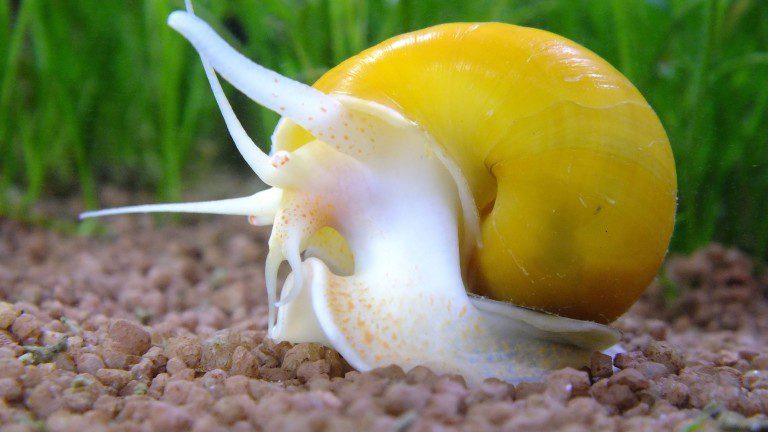
Ampoule: maintenance, reproduction, compatibility, photo, description

Snail (Pomacea bridgesii) is a freshwater snail widely used by aquarists around the world. This mollusk comes from the Amazon basin in South America. This type of gastropod is also widespread in many countries located in the tropics.
In Europe, ampoule appeared relatively recently – only at the beginning of the XNUMXth century. However, it immediately gained popularity among aquarium lovers, which is understandable, since this snail is distinguished by its large size, beautiful, bright colors, and ease of maintenance.
Kingdom Animals Phylum Mollusks Class Gastropods Order Mesogastropods Family Ampullariiidae Genus Pomacea Almost does not differ from relatives in the subclass Pronebranchial. All of them belong to the class of gastropods. This is an invertebrate animal with a well-developed sense of smell.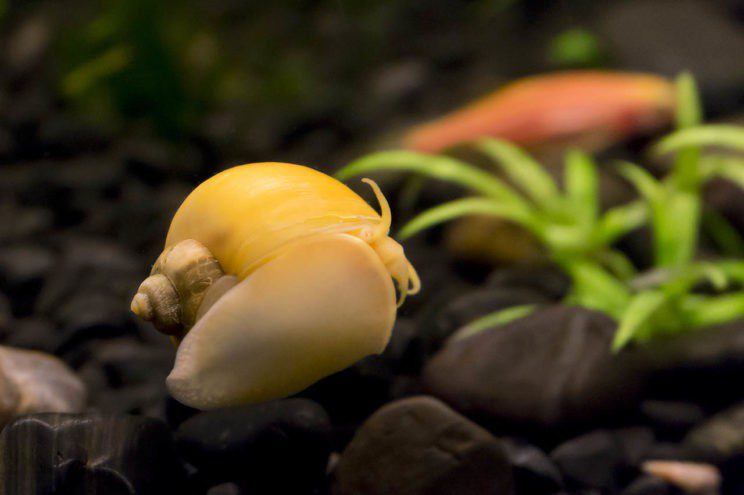
Appearance
The body of a snail has a head with a pair of tactile tentacles, a leg, and an visceral sac. bag covering
a spirally curled shell. The long muscular leg is used for locomotion. On the back there is a lid that seals the mouth of the shell in case of danger. The size of the aquarium snail depends on the species and can range from 5 cm to 15 cm.
The complex respiratory system is of interest. The snail has gill slits on the right side. They supply oxygen dissolved in water. On the left side are the lungs. Ampoule lives under water. But about once every ten minutes, she needs to receive atmospheric oxygen. To do this, the animal rises to the surface, pulls out the breathing tube-siphon and rhythmically sucks in air.
Instead of jaws, snails have special graters – radulas. They scrape food with them. There are eyes. But mollusks almost do not see. They can only distinguish a dark object from a light one. FACT: Apple snails have the ability to regenerate. Within a month, she will regrow any lost organ, including her eyes.
Ampoule care
The ampoule snail is very easy to care for, its maintenance can be entrusted even to a primary school student. In order to maintain an average temperature in the aquarium, a water heating lamp is successfully used. If the snails get cold or they just want to soak up the warmth, they gather on the wall from the side where the light warms. The aquarium must be covered with a lid, otherwise, if your “horned” pets do not like something in their home, they will simply get out of there and go for a walk.
In this case, you need to find out what prompted them to escape and eliminate the inconvenience. Runaways, if you carefully examine the places near the aquarium, you will immediately find that they are not able to crawl far. From time to time, the ampoule snail crawls out to breathe air; for this, there must be free space between the edge of the water surface and the lid of the aquarium. It is interesting to watch the tricks of the yellow beauties, as they look very funny, especially when they do it together, in several individuals.
First, the snail, filled with air, floats up, then exhales, then falls to the bottom with a loud gurgle. Some beginners in breeding snails, seeing for the first time such actions of their pets, are frightened, deciding that the poor creatures have breathed their last breath and collapsed dead to the bottom. This, of course, is not so, everything is in perfect order with the “stags” – they breathed some air and immediately rested.
Diet
Now let’s talk about what ampoule snails eat. This question is the easiest, since beautiful creatures are literally omnivores. Horned creatures eat everything that they can swallow or grind. Feed should be given in such quantities that the snails are able to eat it. It is almost impossible to overfeed aquatic beauties, but if you give a lot of food, pollute your aquarium. In no case should these large snails starve, they are large in size among their other brethren, and for a normal existence they need increased nutrition.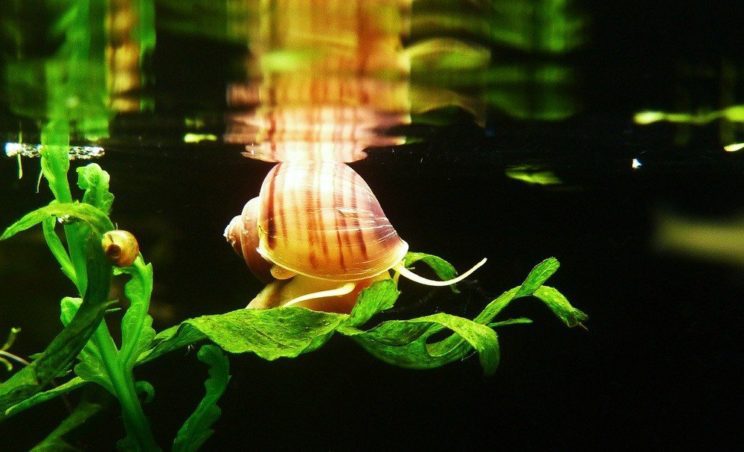
It often happens that among the owners of huge aquariums, snails die of hunger and exhaustion for the simple reason that these slow animals in a large group of nimble fish could not get their own food. They lacked the food that the negligent owner of the fish kingdom gave.
Ampoules are happy to eat food of animal origin: earthworms; bloodworm; daphnia; pipe maker. But the main part of the snail’s food should be greens and vegetables: cabbage leaves; vegetable marrow; lettuce leaves; pumpkin; cucumber; spinach; carrot.
Features
In the wild, these snails are very widespread. Moreover, in some regions, people are struggling with the growth of the snail population, because such snails are pests of wetland ecosystems, displacing other species of gastropods from their habitat.
And because of their omnivorous nature, snails pose a serious danger to crops, especially rice. For example, in the European Union there is an active ban that restricts the import and distribution of this type of snail.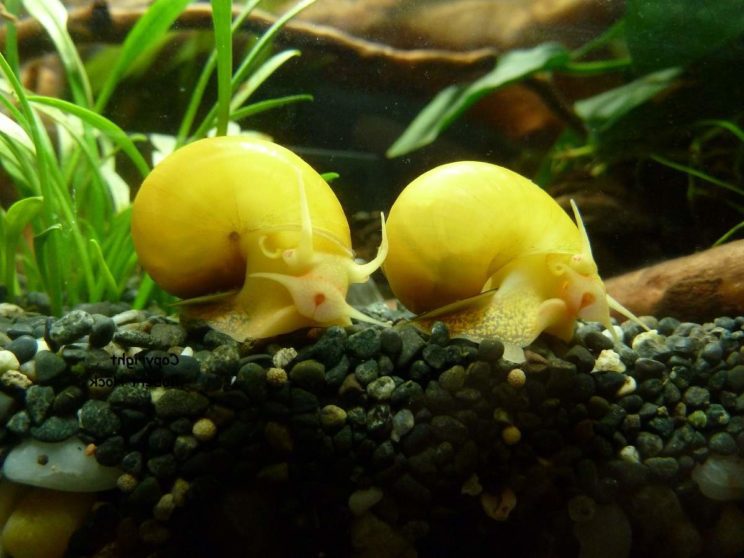
Respiratory system
Breathing in this species of snails is very specific, it resembles the respiratory system of lungfish, which have both gills and lungs. Most of the time, the ampoule is under water, breathing with the help of gills located on the right. But sometimes it floats to the surface of the water, sticking out a breathing tube to saturate the lungs with oxygen from the atmosphere.
BREEDING
How do ampullaria reproduce? Unlike many aquarium snails, they are not hermaphrodites and you need a male and a female to breed successfully. The easiest way to get such a pair is to buy 6 snails at once, which practically guarantees individuals of different sexes. When they become sexually mature, they will begin to breed themselves, in order to stimulate them, no action is needed. How to understand what happened? During mating, the male and female merge with each other, with the male always at the top.
After mating is completed, the female emerges from the water and lays a large number of eggs above the surface of the water. The caviar is pale pink in color and should be above the surface of the water, without plunging into it, otherwise it will simply disappear. The surface of the caviar is calcified under the influence of air and the babies are obtained in complete safety.
Small snails hatch in a few weeks, provided that the ambient temperature is 21-27C and the humidity is sufficient. Newborns are quite large, fully formed and do not require any special care.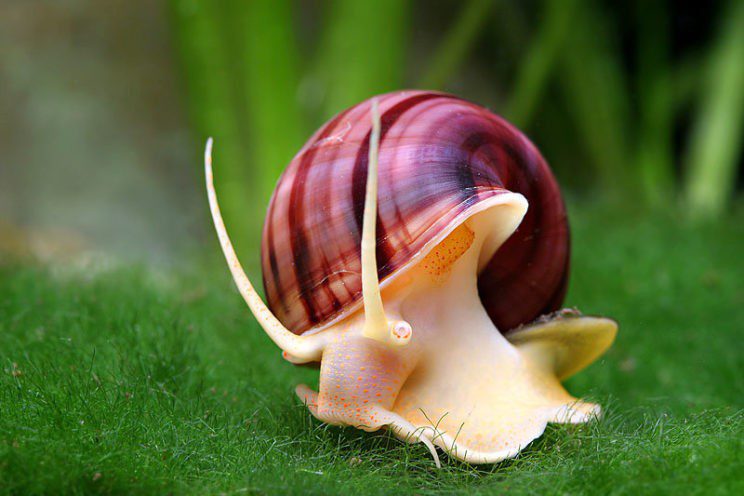
Yes, some species can, especially if they are hungry. How to fight? Feed them to the fullest.



